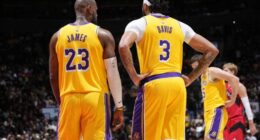It would be premature to say Kobe Bryant getting his nose broken by Dwyane Wade at the All-Star game was the turning point of his season; because by its definition a turning point implies Kobe has been having a sub-par season. He hasn’t.
However from the team’s standpoint, Kobe’s Lakers have hit rock-bottom several times this season. The team started the season 0-2 (0-4 if you want to count the pre-season games), they’ve been abysmal on the road (highlighted by stinkers in Orlando and Miami), and get this, at the mid-way point of this shortened season the Lakers actually sat behind the Clippers in the Pacific Division standings for the first time in an eternity.
Sure, Kobe Bryant has led the league in points per game for most of the season, and his impressive streak of four straight games of scoring 40-plus points was impressive. But Bryant had to face the music: he was stuck with an aging roster that fans and experts around the league were beginning to write off as yesterday’s news. So what exactly did Kobe Bryant have to play for?
Kobe is as indestructible as any human gets, we already know that. But at the back of everyone’s mind lingered the thought, just exactly how much could Bryant play through before he began to show signs of erosion? I mean the dude is in his sixteenth NBA season at the age of 33.
He recently came out and said that he has no rivals in his career and all he’s motivated by is championships: “At this point my rivals, in terms of what I have left to accomplish in my career, (left the game) when Magic (Johnson) and Michael (Jordan) retired in ’98. That’s it. In terms of what I’m looking to accomplish, that’s about it.”
It’s a typical Bryant comment. He adamantly refuses to admit any sign of weakness or give credit to anyone else in the league besides those he grew up idolizing.
The truth is Bryant has had rivals in his illustrious career. He’s just outlasted all of them. In the early part of his career, he was in a constant battle to prove himself as the premier perimeter player in the league; the short list read Bryant (with the afro), Allen Iverson, Tracy McGrady and Vince Carter. AI, T-Mac and Vinsanity were arguably better at their primes than Bryant, but none of the three have been able to match Kobe’s staying power once their athleticism and quickness abandoned them. Iverson can barely crack an NBA team nowadays, and the other two former All-Stars are now reduced to role players on their respective teams.
Now Bryant is the last of a dying breed, as he faces the era of the Twitter-friendly super-friends.
While Kobe may never be Michael Jordan in terms of how he dominated the league year-in and year-out, he’s accomplished what only Michael has been able to do: end an era prematurely while fending off the next one for as long as humanly possible.
But the original question still hasn’t been addressed: how was the All-Star game the turning point to the Lakers season?
Well here’s the truth, Kobe might have met his greatest rival this season.
Himself.
With Andrew Bynum’s emergence as a legitimate offensive force this year, coupled with Bryant’s inevitable decline. Some have questioned Kobe’s decision making down the stretch. It appears some games, Kobe takes it upon himself just to prove to the team he’s still the alpha-dog.
Case in point, during the Raptors game last month, the Lakers led by as much as 18 points. Then, in the fourth quarter, the Raptors began chipping away at the lead. Instead of slowing down the game by taking advantage of the Lakers’ clear mismatch in the post (Bynum vs. Jamaal Magloire and Aaron Grey), Bryant tried to shoot the Lakers out of the rut. During the Raptors’ 12-2 run, Kobe missed five straight contested jumpers, each shot more difficult than the last. If Kobe’s ego hadn’t gotten in the way, the Lakers wouldn’t have needed him to nail the baseline game-winner.
Some nights Kobe’s hero ball results in wins, other nights, take for example the last two nights in Washington and Detroit, hero ball is the biggest detriment to this current Lakers team as their biggest strength now lies in their big men.
By having his nose broken by Dwyane Wade at the All-Star game, it’s forced Kobe to accept his human limitations. In his first three games with the infamous mask on, he averaged 34 points on efficient shooting nights. More importantly, the Lakers went 3-0 in that stretch, eclipsing the Clippers temporarily in the standings.
Culturally, the mask has made Kobe a conversation point across North America again. People are tuning in to see Kobe’s new look. It’s trending on Twitter. Heck, the mask is so inspiring it compelled me to wear one to an intramural basketball game this past Monday.
Experimenting with five different masks is Kobe’s way of telling the world he needed a way to shift the attention from Linsanity back to himself.
The mask is also a reminder that no matter how hard his opponents may try, he’ll still come back swinging. For a broken nose and a concussion are like his rivals, temporary, while his performance and class are immortalized forever.
It also serves as a reminder the only man that can stop Kobe Bryant is himself.







